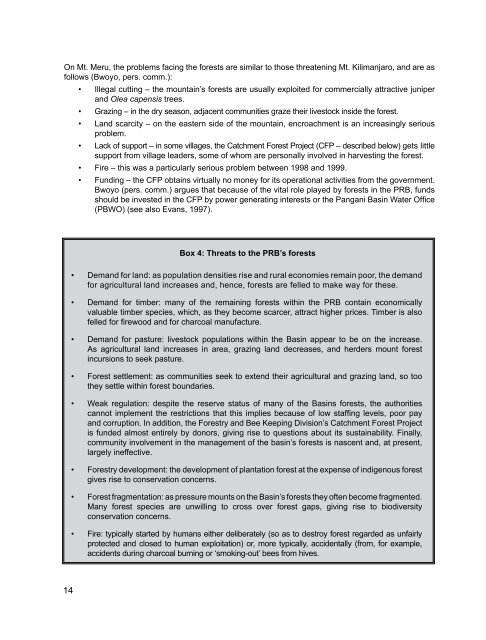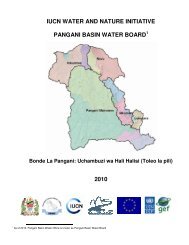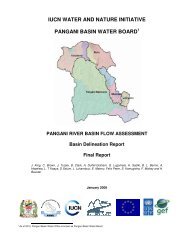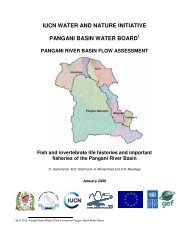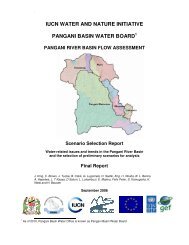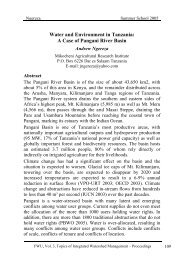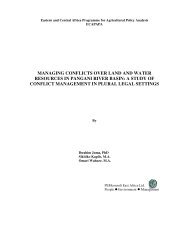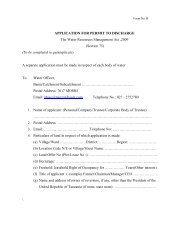PANGANI BASIN WATER BOARD
PANGANI BASIN WATER BOARD
PANGANI BASIN WATER BOARD
Create successful ePaper yourself
Turn your PDF publications into a flip-book with our unique Google optimized e-Paper software.
On Mt. Meru, the problems facing the forests are similar to those threatening Mt. Kilimanjaro, and are as<br />
follows (Bwoyo, pers. comm.):<br />
• Illegal cutting – the mountain’s forests are usually exploited for commercially attractive juniper<br />
and Olea capensis trees.<br />
• Grazing – in the dry season, adjacent communities graze their livestock inside the forest.<br />
• Land scarcity – on the eastern side of the mountain, encroachment is an increasingly serious<br />
problem.<br />
• Lack of support – in some villages, the Catchment Forest Project (CFP – described below) gets little<br />
support from village leaders, some of whom are personally involved in harvesting the forest.<br />
• Fire – this was a particularly serious problem between 1998 and 1999.<br />
• Funding – the CFP obtains virtually no money for its operational activities from the government.<br />
Bwoyo (pers. comm.) argues that because of the vital role played by forests in the PRB, funds<br />
should be invested in the CFP by power generating interests or the Pangani Basin Water Office<br />
(PBWO) (see also Evans, 1997).<br />
Box 4: Threats to the PRB’s forests<br />
• Demand for land: as population densities rise and rural economies remain poor, the demand<br />
for agricultural land increases and, hence, forests are felled to make way for these.<br />
• Demand for timber: many of the remaining forests within the PRB contain economically<br />
valuable timber species, which, as they become scarcer, attract higher prices. Timber is also<br />
felled for firewood and for charcoal manufacture.<br />
• Demand for pasture: livestock populations within the Basin appear to be on the increase.<br />
As agricultural land increases in area, grazing land decreases, and herders mount forest<br />
incursions to seek pasture.<br />
• Forest settlement: as communities seek to extend their agricultural and grazing land, so too<br />
they settle within forest boundaries.<br />
• Weak regulation: despite the reserve status of many of the Basins forests, the authorities<br />
cannot implement the restrictions that this implies because of low staffing levels, poor pay<br />
and corruption. In addition, the Forestry and Bee Keeping Division’s Catchment Forest Project<br />
is funded almost entirely by donors, giving rise to questions about its sustainability. Finally,<br />
community involvement in the management of the basin’s forests is nascent and, at present,<br />
largely ineffective.<br />
• Forestry development: the development of plantation forest at the expense of indigenous forest<br />
gives rise to conservation concerns.<br />
• Forest fragmentation: as pressure mounts on the Basin’s forests they often become fragmented.<br />
Many forest species are unwilling to cross over forest gaps, giving rise to biodiversity<br />
conservation concerns.<br />
• Fire: typically started by humans either deliberately (so as to destroy forest regarded as unfairly<br />
protected and closed to human exploitation) or, more typically, accidentally (from, for example,<br />
accidents during charcoal burning or ‘smoking-out’ bees from hives.<br />
14


